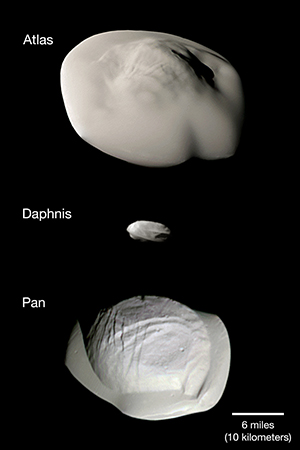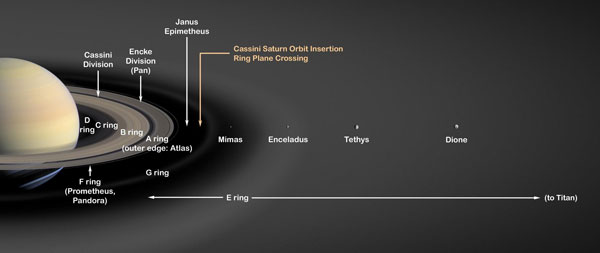A new study of observations from NASA's Cassini sheds light on the tiny moons that orbit within Saturn's vast ring system.

NASA / JPL-Caltech / Space Science Institute
At least five of the small moons dancing among Saturn’s rings likely formed as icy material from the planet’s rings built up around tiny cores.
That’s the scenario favored by Bonnie Buratti (Jet Propulsion Laboratory) and colleagues March 28th in Science. The scientists came to this conclusion using images and other data taken by the Cassini spacecraft as it whizzed close by the moons Pan, Daphnis, Atlas, Pandora, and Epimetheus five times between December 2016 and April 2017. The flybys were part of the "Ring-Grazing" phase of the spacecraft's final orbits.
Planetary scientists have long wondered about the relationship between the rings and these tiny moons. The moons Daphnis and Pan dwell in gaps in Saturn’s ring A, the outermost of the main ring system. Atlas skirts A’s outer edge and Pandora shepherds the narrower ring F, which lies just outside A. Epimetheus lies beyond the F ring.
The observations show that the moons are low-density and have porous surfaces. These properties support the idea that they were created by the buildup of icy ring material, perhaps around the shards of an earlier moon that broke up near Saturn. The closer each moon is to Saturn, the redder it is. Each moon’s hue appears to be a unique give-and-take between the reddening from an unidentified substance and bluer water ice from the tenuous E ring, which was created by material spewed from Enceladus’s geysers.

NASA / JPL
The moons have also clearly survived some complex geologic happenings: They’re marred by grooves from tidal stresses, and Pan and Atlas both have ridges around their equators that make them look like ravioli. These are probably made of material accreted from the rings, the scientists write.
Reference:
B. J. Buratti et al. “Close Cassini Flybys of Saturn’s Ring Moons Pan, Daphnis, Atlas, Pandora, and Epimetheus.” Science. March 29, 2019
 0
0









Comments
You must be logged in to post a comment.